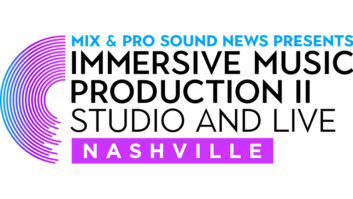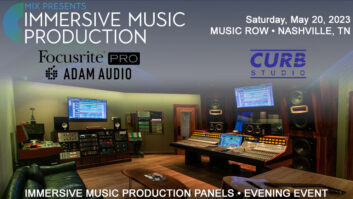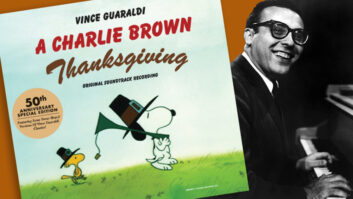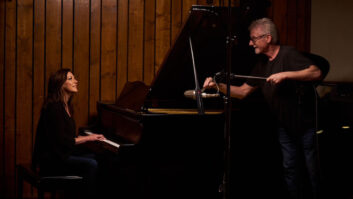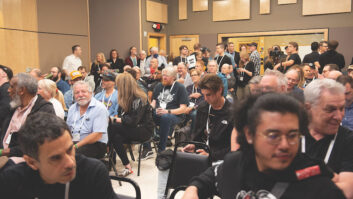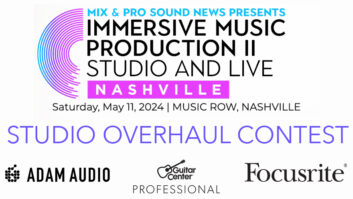Producers & Engineers Working in Busy Nashville Scene get “Consistency and Killer Sound” Mixing with Dangerous 2-Bus Analog Summing
“We’ve moved off consoles and we are all in the box with the Dangerous 2-Bus,” says Richie Biggs, engineer on the Civil Wars hit album. “We’ve been happy for several years now. We haven’t really mixed anything without the Dangerous 2-Bus since getting off the console.” The mixing duo recently added the Dangerous D-Box, with its combination of analog summing and monitor control, in their second studio room to keep projects flowing. “We’re using the Dangerous D-Box in a second room. We mix with the summing all the time in both rooms. Jacquire King recommended the 2-Bus to me; he’s done a few of the Kings of Leon records and the next to last Norah Jones record. He lives here in town and he uses a 2-Bus exactly like we’re using it,” says Biggs.
Referring to recapturing the sound of an analog console in their mixes, Charlie Peacock, the producer and co-engineer on the Civil Wars album, states, “The Dangerous 2-Bus was a step in the right direction as far as restoring width and depth to the sound, and also ease of mixing — I feel like I’m working in half the time now. The Dangerous 2-Bus has definitely sped up what we do.”
Being busy mixing in Nashville means that recall is king. “We are working on 2 or 3 records at the same time, every day. Within a hour we switch records.” With the 2-Bus and D-Box being true summing mixers instead of line mixers, having no pan or level knobs, it makes recalling mixes simple. Everything is saved and set in Pro Tools. “All the inputs are set to stereo on the 2-Bus, I don’t have anything in mono. I have the master output control on the 2-Bus at about 1 o’clock, so the 2-Bus sits still,” says Biggs. “More than 1 o’clock is a little bit too much. 12 o’clock is good, as Dangerous Music recommends, but I felt like that extra bump, it’s just a little bit more!” (laughs)
Because they work on so many projects at once, the obvious progression of a production is always that a mix needs a touch up, and the two rooms equipped with the Dangerous 2-Bus and the Dangerous D-Box allows them to work efficiently. “We have two mix rooms that we work out of and a total of 5 workstations. We’ve got to be confident that when we pull up our track on whatever workstation we’re in the ballpark — and be especially confident when Richie is taking the same mix between two different mix rooms. That’s what’s really essential,” says Peacock.
Having spent years mixing on analog consoles Biggs and Peacock wanted to retain analog capabilities when they went to Pro Tools and mixing in the box. “Like everybody else we auditioned every possible means to get back to where we were on a console, as we all adjusted to working in a DAW world. Learning how to grow and improve our sound from there, we tried everything. And really, the Dangerous 2-Bus has been the solution for us.”
Besides a more pronounced width and depth to the sound when mixing through the 2-Bus, they feel that the sound also has better “front-to-back depth” and that using the 2-Bus to sum the reverb makes a huge difference as well. “I not sure if I’m the only one that feels this way but reverbs in the box have been so drastically different than on a console in the past. So having the Dangerous 2-Bus sum those effects returns along with the tracks makes a huge difference in the sound. I’ve got 2 or 4 effects inside Pro Tools that are going through their own dedicated outputs right to the 2-Bus.”
“We have three AVID 192 IO interfaces, most of that’s for inputs for tracking, then 16 outputs to the 2-Bus, then I use extra outputs for patching if need be,” says Biggs. Because of their consistency with analog outboard gear and keeping settings pretty much the same all the time, this allows for a lot of project flexibility. The outboard gear stays “sort of static and that gives us the option to jump from project to project,” adds Peacock.
Biggs explains that the 2-Bus has a “clean, open sound” that allows him to put the color into a mix with his own choices of analog gear, rather than being forced to start off in a direction he may not like, “I’ve worked in other rooms that have summing boxes, and one of the things that I find to be a turn-off is that if they’re really sonically ‘colored’ — that’s almost as bad, to me, as the ‘blank slate’ sound quality of in-the-box mixing. I feel like Dangerous gives me the ability to not have to deal with a negative like that from the get-go.”
Peacock agrees, “We always want to be in control of choosing which elements in the chain are somewhat neutral and those which have a color, like when to use a box that has it’s own opinion, and wants to ‘be something’ — we want to be the director that’s casting these roles, we don’t want to be stuck with something that is not the role we want to put it in. We love the combination of the way the Dangerous 2-Bus works and how it still allows us to add color pieces when, where and how we want in the analog realm.”
Their studio is set up with some of the Pro Tools D/A outputs hard-wired directly to outboard gear like EQs and compressors. These processed outputs are directly connected to some of the 2-Bus inputs and get summed with the other unprocessed tracks, all in the analog domain. This makes the production process easier – to select a track and add analog processing to it, simply choose the Pro Tools output that has the compressor or EQ ‘in line’ to the 2-Bus analog summing input; like a patchbay or an insert on an analog console. They also have analog processing on the 2-Bus stereo main output. “On the master output we’ve got Shadow Hills and SSL gear patched across the stereo mix. And I’ve got about 8-channels of discreet things that I pass through in and out of the 2-Bus,” explains Biggs.
Their system is very finely tuned at this point, and they aren’t searching for new gear. But their process of working with equipment goes something like this, “We start with a piece of gear and then we start asking questions about the piece of gear, ‘Why doesn’t it do this?’ ‘I wish is did that’ and then it’s either we try to get somebody to do that for us or it’s timely that other people are thinking the same thing: sometimes someone like Dangerous comes out with a product that matches our needs. Right now we are in a groove, and it is streamlined, we have our work flow, and we’re confident about it,” says Peacock.
Biggs and Peacock plan to reunite with the “Civil Wars” in the fall. “We’re getting ready to do their next album, we hope we’re started by September.” And they’ll be mixing with the Dangerous 2-Bus and Dangerous D-Box again.
About Richie Biggs and Charlie Peacock
Most recently Richie Biggs has been busy mixing the two-time Grammy® winners The Civil Wars with Charlie Peacock at the production helm. The pair has worked together over the past 15 years recording hits for acts such as Switchfoot, Holly Williams and Amy Grant. Richie has also recorded and/or mixed for George Strait, JD Souther, and Michael W. Smith among many others. Charlie Peacock is a Grammy® Award-winning, multi-format artist, songwriter and record producer working in pop, gospel, country, Americana, and jazz in various capacities, including A&R with EMI and Sony/ATV, and he is currently Sr. VP of A&R for Twenty Ten Music. Some of the artists Peacock has worked with—besides the records with Biggs—include Ladysmith Black Mambazo, Bela Fleck, Al Green, Sam & Ruby, and CeCe Winans to name only a few. Billboard’s Encyclopedia of Record Producers named Peacock one of the 500 most important record producers in music history, with over 20-Million sales to his credit.
Find out more about Charlie Peacock, contact: Steve Moir at Moir Entertainment 1250 6th St., Suite 401, Santa Monica, CA 90401; Phone: 310-656-3150 or email: [email protected]
To see more of Richie Biggs’ credits visit AllMusic
About Dangerous Music
Dangerous Music, Inc. designs and builds products that are indispensable to any DAW-based recording environment. Dangerous Music electronics designer Chris Muth has spent over 20 years working in and designing custom equipment for top recording and mastering studios. Muth and company founder Bob Muller pioneered the concept of the dedicated analog summing buss for digital audio workstations with the Dangerous 2-Bus in 2001. Today the company offers a wide range of products for recording, mastering, mixing and post-production facilities, all designed and built with mastering-quality standards and a practical aesthetic. Key products include the Dangerous 2-Bus and 2-Bus LT, Dangerous Monitor ST-SR and its Additional Switching System expansion units, Dangerous D-Box, Dangerous Master, Dangerous Liaison, Dangerous Monitor and Dangerous Bax EQ.
For more information on Dangerous Music visit http://www.dangerousmusic.com phone 607-965-8011 or email: [email protected]
All trademarks are the property of their respective holders. Description and specifications are subject to change without notice.
